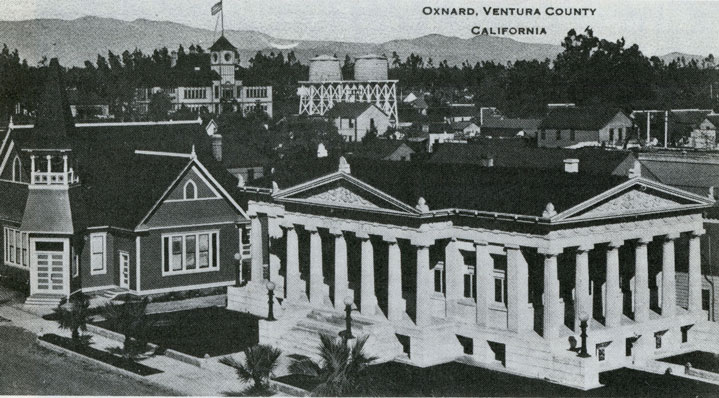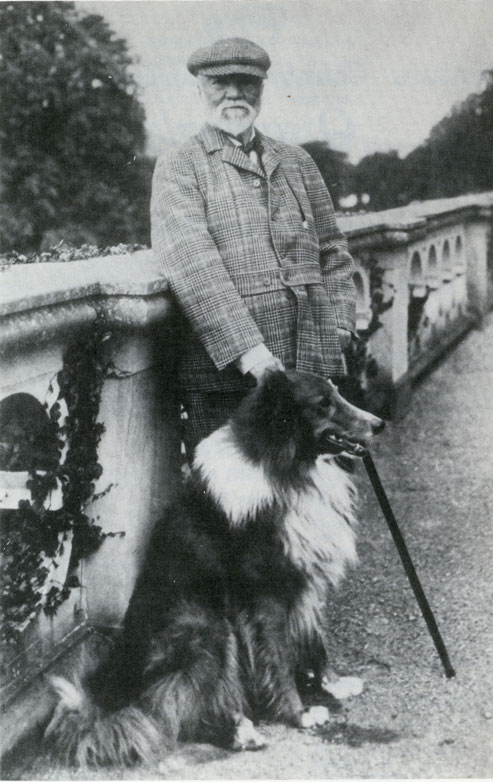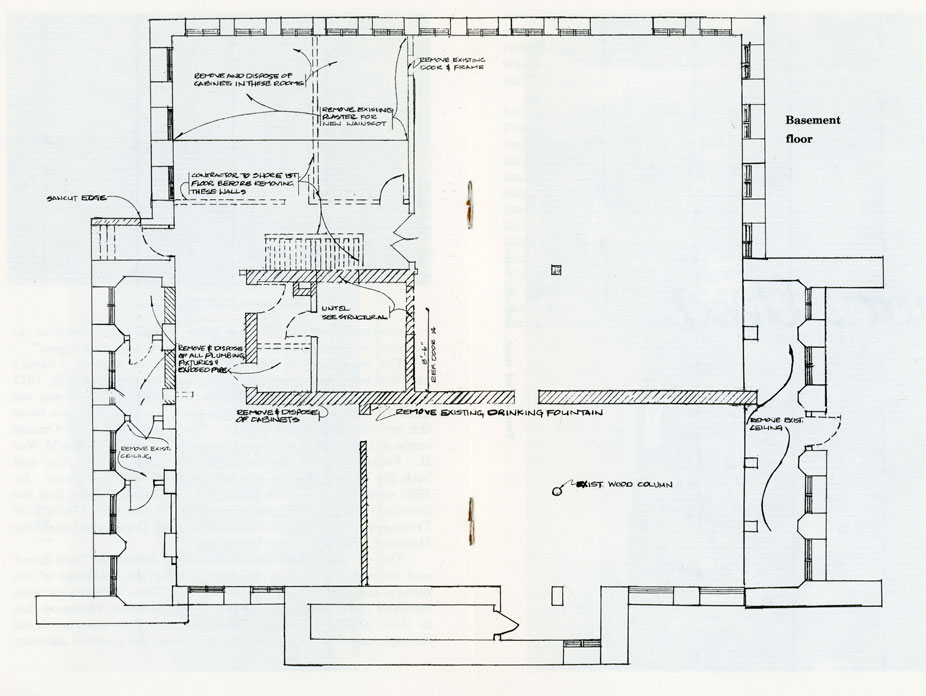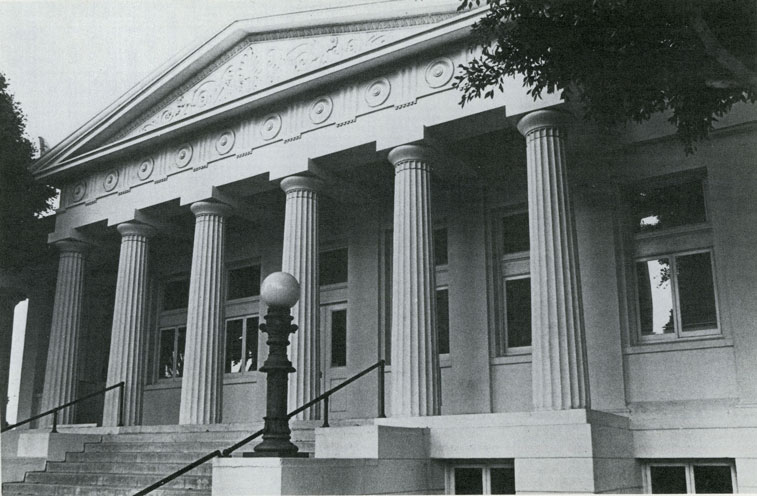By Emilie Ritchen
In this 1981 article the author gives a brief history of the Carnegie library. He recounts how the community came together to secure funding for the project. After the move to a new building in 1963, the building became the home to Oxnard’s Chamber of Commerce and other government offices, before becoming the Carnegie Art Museum. However, the museum closed its doors in 2019. This same building, for which the community came together to create a cultural and educational center, still stands at Park Plaza awaiting its fate. This was taken from MVC Quarterly Volume 26 Number 3 (Spring 1981). This article will be the first in a short series on the Oxnard Public Library. Stay tuned!
In 1906 Oxnard was a young, ambitious and energetic community. It had only been in existence since 1898 and was incorporated in 1903. The residents were people who wanted to make this their permanent home: a place to bring up their families in an environment that would not only provide the necessities of life, such as comfortable homes and a means of livelihood, but would also contribute to their cultural needs. They realized that the first step to meeting the latter was to establish a free library where people could obtain the required reading materials and which would also serve as a cultural center.
This was a fortunate time for small growing communities whose dreams and visions of the future were large and ambitious, but whose means to fulfill those plans were quite limited. In those years there was a benevolent multimillionaire, Andrew Carnegie, who had immigrated to the United States and made a vast fortune in the steel industry. He was very grateful for all the opportunities that he had received in this country and wanted to share some of his financial success for the betterment of its people. To show that appreciation he created endowment funds to be given to universities and to help build free public libraries throughout the country.
Mr. Carnegie was a generous man, but he was also a canny Scotsman who wanted to be sure that his gifts would be used properly. Certain requirements and guarantees had to be met by the cities requesting his assistance. Fortunately, Oxnard had some leaders who were good businessmen too and had a great deal of foresight. Two of the leaders in the movement to obtain a library were Richard B. Haydock, who was the mayor at that time, and Isaac W. Stewart, who was the city attorney.
Mr. Haydock was an educator and a man with great drive and persuasion. Before making their request to Mr. Carnegie, these men and the other members of the Board of the Council had investigated the necessary requirements to obtain the desired grant. They drew up the proper resolutions, and put into action all the work of acquiring deeds and other documents to insure the acceptance of their request for financial assistance.
REQUIREMENTS
“1st The city must provide the site for the proposed library.”
They found the ideal place; and to quote from a newspaper dated February 9, 1906, “The Board of the Council has acquired the most sightly and convenient location in the entire town.” The lots that they wanted were owned by the Colonial Improvement Co. and a Mr. Cryer of Los Angeles.
His property was purchased with city funds. Henry T. Oxnard and some of his close associates, who were part of the Colonial Improvement Co., donated their share of the property; and the other members of that company were paid from the city treasury.1
“2nd The city must pledge their support of the library project by not less than $1,000 a year.”
In anticipation of this requirement the Council passed a resolution to levy an annual tax of not less than $1,000 for the support of the library, and to increase the amount as the town and the need grew.
“3rd The city should provide funding for the furnishings of the proposed building.”
This money was subscribed by the following gentlemen: Thomas A. Rice; Sam W. Wineman; Achille Levy; James A. Donlon and the Lehmann brothers.2
All of the documents and resolutions were sent to Mr. Carnegie, who in turn agreed to give $10,000 for the building project3
An architect, Franklin P. Burnham, was hired to draw up the plans for the library,4 and they were put out for bid. The lowest bid was that of Thomas H. Carroll, and even his figure was over the estimate.5 So once again they approached Mr. Carnegie, and he agreed to contribute an additional $2,000.6
Construction began and as one newspaper article records, “Mr. Haydock checked on the excavation and foundation every day to be sure that it would be strong enough to stand for all time.” As far as the actual work was concerned, this was not the easiest time to do any building in California. On April 18, 1906, San Francisco had been devastated by an earthquake and fire; and there was a great demand for materials and workmen to rebuild that city. Finally, the building stood completed, and a celebration was held on the evening of May 15, 1907. While this was a formal dedication, it was intended to be a simple affair; and in one article a statement is found requesting that the men not wear dress attire and that the ladies not don evening gowns. A quotation from the speech of the mayor, Samuel B. Bagnall, best expresses the sentiments of the time:
Liberal as was Mr. Carnegie’s donation, such as it should be and is appreciated, glad as I am to acknowledge our obligation to him for his generosity: still, my friends, I sincerely hope there will be no question in your minds as to the honesty of my words when I say that I feel greater pride in the part that you yourselves have played. You have contributed just as cheerfully and far more liberally in proportion to your means, and your obligations have only just begun.7
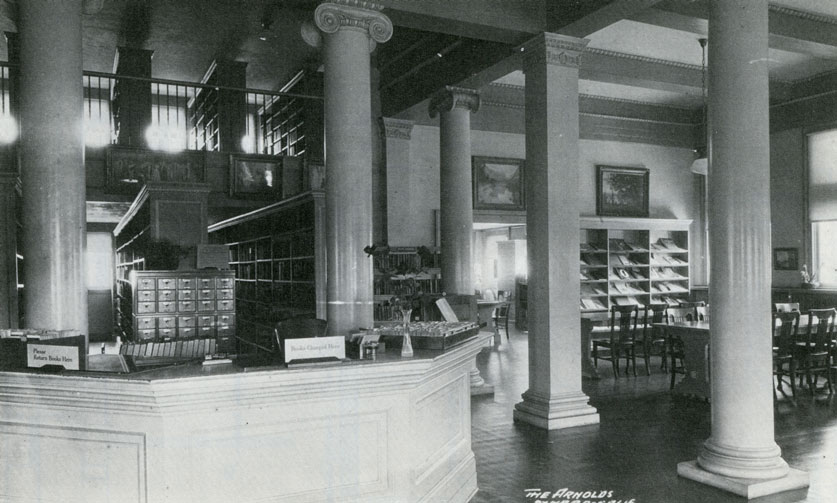
The main floor of the building was to be used as a library and the basement area was to become the city hall. By 1917 there was talk about adding on to the building; but it was not until 1923 that the expansion was made, making the space twice the size of the original facility. The years passed and Oxnard made a rather slow yet steady growth. Then came World War II. From there on the town began to grow more rapidly, and both the library and the city hall were crowded to capacity. By 1950 something had to be done. It is difficult to believe that the basement area still housed the offices of the City Clerk, City Treasurer, Water Department, Engineering Department and City Manager, and the Council chamber.
The city purchased the old Roosevelt School on Third Street and converted it into a city hall, leaving the basement of the library building for expansion of its facilities. Partitions were removed (there was some structural reinforcement necessary due to their absence), it was painted, and new floor covering laid throughout. It was also at this time that the circular stairway was removed, thereby giving more floor space on the main floor and eliminating a hazard. In February 1950 the new children’s room and auditorium in the basement were opened. This project was anticipated: the money for the necessary work was on hand; and no additional tax was required for the project.
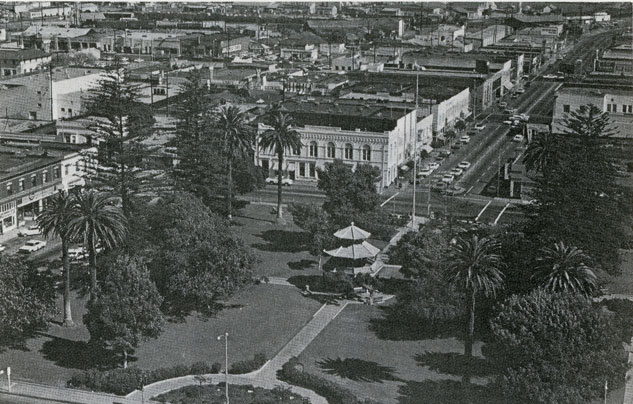
The town was now growing by leaps and bounds, and the building could not be expanded further; so the new Oxnard Public Library was built and opened in 1963. Buildings are very much like people. They have their own personalities, they have their own aura, and this old one always radiated warmth and friendliness. It was filled with memories of people and events of times past, and it was with very mixed emotions that the move was made to the new building.
For a time, the building was the home of the Chamber of Commerce and the Art Club. Then came the fateful news that the structure was unsafe and could no longer be used unless it was reinforced, etc. For a time, we who loved this majestic monument feared that it would be destroyed. But through the understanding and hard work of many people, it was saved and now has come back to be an active cultural center once again.
- $900 was paid to Cryer of the $3,400 price of the site. Mr. Oxnard and his associates donated $1,861.63. $638.37 was paid to the other Colonial Improvement Co. members which included Mrs. Arnetta Rice Hill.
- The furnishings along with the doors of the vault and the furnace cost $1,000. The subscription raised $750: Mr. Rice, $250; Mr. Wineman, $100; Mr. Levy, $150; Mr. Donlon, $150; and Lehman Bros., $100.
February 13, 1906
R.B. Haydock, Esq., Oxnard, California
Dear Sir:
Responding to your communication on behalf of the City of Oxnard, if the city agrees by resolution of council to maintain a free public library at a cost of not less than one thousand dollars a year and provide a suitable site for the building, Mr. Carnegie will be glad to give ten thousand dollars to erect a free public library.
Oxnard, California
Respectfully yours,
- The architect’s fee was $692.75.
- The building contract was $13,855; the cost was $16,016.
- The Board was seeking $5,000!
- Citizens contributed $1,370. Extra assessments for the contractor of $309.43 and on the foundations of $250, and improvements around the grounds of $300 were additional.

